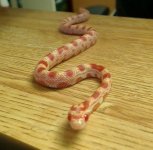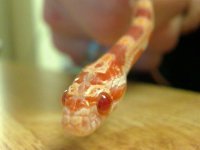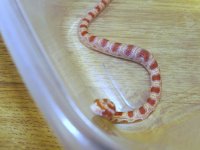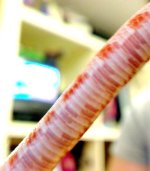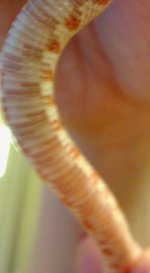Candyflipz
New member
Just finished reading Kathy and Bill Love's book The Corn Snake Manual cover to cover in about 3 hours. I've never read an equally educational book so intently and quickly before!!
I have to say it's THE greatest resource I have found in learning about the variable morphs out there and developing a strong foundation to understand the many types of inheritance in the different traits discovered so far.
I will admit I'm pretty biased on the subject of genetics as I am in the process of earning a Bachelor's degree in Biology or Biochemistry (declaring my major this semester :uhoh: ) with a concentration in molecular biology and genetics. I've learned so much about the methods of inheritance that occur in humans and many other animals so grasping the genetic information provided in the Loves' book may be easier than someone with no prior understanding on the subject
:-offtopic I can't ignore the first two thirds of the book that outlined basic care and breeding practices that I haven't been able to find so detailed anywhere else...even the internet! I never TRULY understood what brumation was or what gravid meant until I read the book. They outline every tiny detail they handle every breeding season.
However, I found the way in which they introduce the information in the genetics section about each morph is extraordinary. Info that can only be provided effectively by herpetologists that have been exposed to the growing corn snake selective breeding culture since the beginning. I was surprised to learn that the beginnings of selective breeding happened so recently! It has only been in the last 4-5 decades since interest was first stirred in the subject.
The manner in which they explained each morph, which conveniently was mostly chronological, was the most straight forward I have had access to. Other resources I have found online simply listed the phenotypes (physical characteristics of a gene), what they looked like, and what the genetic makeup was. I am quite accustomed to receiving information in this way in the course of my education, but even I found the modes of inheritance confusing! Kathy and Bill spelled out each morph beginning with how it was discovered, where, by who, and what the mutation meant both genetically and physically. The information was "dumbed down" enough to easily grasp, but still had all the information necessary to truly understand each genetic mutation. They easily walked you through every morph, and when it became time to understand more complex morphs it was much more straight-forward to understand.
But in learning all this from the book, I can't make a decision on my own baby (the only snake I own). I got him from a pet store that didn't even know how to sex snakes, let alone did they care what their genetic makeup was. I originally thought he is amelanistic, since I was under the impression they were more common and therefore more likely to be less valuable "rejects" a breeder might sell to a pet store. But now I believe he could be a reverse Okeetee??? I'll post some pictures. I want your opinions!!! He's definitely still a baby so it will probably be difficult to know until he's grown...even difficult then.
In any case, I hope you fine ladies and gents can give me your opinion, but more importantly, if you haven't already, go read this book!! I hope to some day meet Bill and Kathy and shake their hands :cheers: I'd say they are DEFINITELY awesomesauce *_~
I have to say it's THE greatest resource I have found in learning about the variable morphs out there and developing a strong foundation to understand the many types of inheritance in the different traits discovered so far.
I will admit I'm pretty biased on the subject of genetics as I am in the process of earning a Bachelor's degree in Biology or Biochemistry (declaring my major this semester :uhoh: ) with a concentration in molecular biology and genetics. I've learned so much about the methods of inheritance that occur in humans and many other animals so grasping the genetic information provided in the Loves' book may be easier than someone with no prior understanding on the subject
:-offtopic I can't ignore the first two thirds of the book that outlined basic care and breeding practices that I haven't been able to find so detailed anywhere else...even the internet! I never TRULY understood what brumation was or what gravid meant until I read the book. They outline every tiny detail they handle every breeding season.
However, I found the way in which they introduce the information in the genetics section about each morph is extraordinary. Info that can only be provided effectively by herpetologists that have been exposed to the growing corn snake selective breeding culture since the beginning. I was surprised to learn that the beginnings of selective breeding happened so recently! It has only been in the last 4-5 decades since interest was first stirred in the subject.
The manner in which they explained each morph, which conveniently was mostly chronological, was the most straight forward I have had access to. Other resources I have found online simply listed the phenotypes (physical characteristics of a gene), what they looked like, and what the genetic makeup was. I am quite accustomed to receiving information in this way in the course of my education, but even I found the modes of inheritance confusing! Kathy and Bill spelled out each morph beginning with how it was discovered, where, by who, and what the mutation meant both genetically and physically. The information was "dumbed down" enough to easily grasp, but still had all the information necessary to truly understand each genetic mutation. They easily walked you through every morph, and when it became time to understand more complex morphs it was much more straight-forward to understand.
But in learning all this from the book, I can't make a decision on my own baby (the only snake I own). I got him from a pet store that didn't even know how to sex snakes, let alone did they care what their genetic makeup was. I originally thought he is amelanistic, since I was under the impression they were more common and therefore more likely to be less valuable "rejects" a breeder might sell to a pet store. But now I believe he could be a reverse Okeetee??? I'll post some pictures. I want your opinions!!! He's definitely still a baby so it will probably be difficult to know until he's grown...even difficult then.
In any case, I hope you fine ladies and gents can give me your opinion, but more importantly, if you haven't already, go read this book!! I hope to some day meet Bill and Kathy and shake their hands :cheers: I'd say they are DEFINITELY awesomesauce *_~

